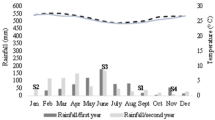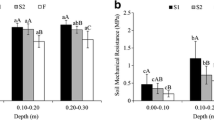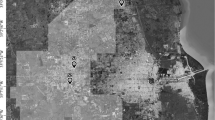Abstract
A feature of many sugarcane fields is the patchy growth. This is often thought to be due to physical or chemical differences in the soil. In this paper we investigate the causes of growth heterogeneity of sugarcane on a sandy soil in KwaZulu-Natal, South Africa. To identify the factors that were associated with the good and poor areas, soil texture, pH, organic matter content and a number of soil chemical elements and nematode community data were subjected to principal component analysis (PCA). The numbers of each of the nematode species (Meloidogyne sp., Pratylenchus zeae, Helicotylenchus dihystera, Xiphinema elongatum and Paratrichodorus sp.) were first converted to relative proportions of ectoparasites and endoparasites. The data were collected from the 2nd ratoon crop of a nematicide trial, where half of the plots had been treated with aldicarb in the preceding two crops. Yields of control plots varied from 34.7 to 126.8 t cane ha−1 and from 85.4 to 138.7 for the treated plots. The yield data were centred and normalised separately for the treated and control plots and the values projected on the trial map to study spatial distribution. Plots with above-average yields, whether treated or untreated, occurred in the lower part of the trial site. The PCA factorial values were also projected onto the map of the trial. According to the first factor of the analysis of the abiotic soil characteristics in the 0–20 cm surface layer, the trial site could be divided into two areas, one on the left and one on the right. PCA of the soil data from the 0–20 and 20–40 cm layers showed that there was little or no difference between the two that might explain the two growth areas. However, analysis of the nematode community distinguished two main areas that largely corresponded to the distribution of the plots of low and high yielding cane. Correlation analysis confirmed the relationship between nematodes and yield. H. dihystera was positively correlated with yield of cane whereas the reverse was true for the Meloidogyne species.
Similar content being viewed by others
References
Barnard R O, Buys A J, Coetzee J G K, Du Prees C C, Meyer J H, van Vuuren J A J, Volschen J E, Bessinger F and Lambrechts J J N 1990 Handbook of standard soil testing methods for advisory purposes. SASEX, Mount Edgecombe, South Africa. 132 pp.
Barret P, Cadet P, Feller C and Albrecht A 1991 Le remodelage des terres à laMartinique. 2. Variabilité intra-parcellaire du remodelage en relation avec la production végétale. Cah. ORSTOM, sér. Pédol. 26, 105-113.
Brown D J F and Boag B 1988 An examination of methods used to extract virus-vector nematodes (Nematoda: Longidoridae and Trichodoridae) from soil samples. Nematol. medit. 16, 93-99.
Brown R H 1987 Control strategies in low-value crops. In Principles and Practice of Nematode Control in Crops. Eds. R H Brown and B R Kerry pp. 351-387. Academic Press, Sydney, Australia.
Cadet P 1985 Incidence des nématodes sur repousses de cannes à sucre au Burkina Faso et en Côte d'Ivoire. Révue Nematol. 8, 277-284..
Cadet P, Thioulouse J and Albrecht A 1994 Relationships between ferrisol properties and the structure of plant parasitic nematode communities on sugarcane in Martinique (French West Indies). Acta OEcologica 15, 767-780.
Castro C E, Belser N O, McKinney H E and Thomason I J 1990 Strong repellency of the root knot nematode, Meloidogyne incognita by specific inorganic ions. J. Chem. Ecol. 16, 1199-1205.
Delaville L, Rossi J P and Quénéhervé P 1996 Plant row and soil factors influencing the microspatial patterns of plant-parasitic nematodes on sugarcane in Martinique. Fundam. appl. Nematol. 19, 321-328.
De Pelsmeaker M and Coomans A 1987 Nematodes in potato fields and the relation to some biotic and abiotic factors. Medelingen van de Faculteit Landbouwwetenschappen Rijksuniversiteit, Gent 52, 561-569.
Kincaid R R 1946 Soil factors affecting incidence of root knot. Soil Sci. 61, 101-109.
Kloepper J W, Rodriguez-Kabana R, McInroy J A and Young R W 1992 Rhizosphere bacteria antagonistic to soybean cyst (Heterodera glycines) and root-knot (Meloidogyne incognita) nematodes: Identification by fatty acid analysis and frequency of biological control activity. Plant and Soil 139, 75-84.
Luc M, Sikora R A and Bridge J 1990 Plant Parasitic Nematodes in Subtropical and Tropical Agriculture. CAB International, Wallingford, UK. 629 p.
McSorley R 1998 Population dynamics. In Plant and Nematode Interactions. Eds. K R Barker, G A Pederson and G L Windham. pp. 109-133. Madison, Wisconsin, USA, Publishers.
Norton D C 1989 Abiotic soil factors and plant-parasitic nematode communities. J. Nematol. 21, 299-307.
Prot J C and van Gundy S D 1981 Effect of soil texture and the clay component on migration of Meloidogyne incognita second-stage juveniles. J. Nematol. 13, 213-217.
Roth G 1971 The effects of filtercake on soil fertility and yield of sugarcane. Proc. S. Afr. Sug. Technol. Ass. 45, 142-148.
Seinhorst J W 1950 De betekenis van de toestand van de grond voor het optreden van aantasting door het stengelaaltje (Ditylenchus dipsaci (Kühn) Filipjev). Tijdschr. PlZiekt. 56, 289-348.
Seinhorst J W 1956 Population studies on stem eelworms (Ditylenchus dipsaci). Nematologica 1, 159-164.
Spaull V W and Cadet P 1990 Nematode parasites of sugarcane. In Plant Parasitic Nematodes in Subtropical and Tropical Agriculture. Eds. M Luc, R A Sikora and J Bridge. pp. 461-491. CAB International, Wallingford, UK.
Spaull V W and Cadet P 1991 Studies on the relationship between nematodes and sugarcane in South and West Africa: Ratoon cane. Revue Nématol. 14, 183-186.
Swarup G and Sosa-Moss C 1990 Nematode parasites of cereals. In Plant Parasitic Nematodes in Subtropical and Tropical Agriculture. Eds. M Luc, R A Sikora and J Bridge. pp. 109-136. CAB International, Wallingford, UK.
Thioulouse J, Chessel D, Dolédec S and Olivier J M 1997 ADE-4: a multivariate analysis and graphical display software. Statist. Comput. 7, 75-83.
Upadhyay R S, Oostenbrink M and Khan A M 1972 The effect of different soil types on the density of nematode populations. Ind. J. Nematol. 2, 42-53.
Villenave C and Cadet P 1998 Interaction of Helicotylenchus dihystera, Pratylenchus pseudopratensis and Tylenchorhynchus gladiolatus on two plants from the soudano-sahelian zone of West Africa. Nematropica 28, 31-39.
Villenave C and Duponnois R 1998 Influence of soil microorganisms on the reproduction of Helicotylenchus dihystera and its pathogenicity to millet. Nematologica 44, 195-206.
Winfield A L and Cooke D A 1975 The ecology of Trichodorus. In Nematode Vectors of Plant Viruses. Eds. F Lamberti, C E Taylor and J W Seinhorst. pp. 309-341. Plenum Press, London and New York.
Wood R A and Meyer J H 1986 Factors affecting potassium nutrition of sugarcane in South Africa. Proc. S. Afr. Sug. Technol. Ass. 60, 198-204.
Author information
Authors and Affiliations
Corresponding author
Rights and permissions
About this article
Cite this article
Cadet, P., Spaull, V.W. & McArthur, D.G. Role of plant parasitic nematodes and abiotic soil factors in growth heterogeneity of sugarcane on a sandy soil in South Africa. Plant and Soil 246, 259–271 (2002). https://doi.org/10.1023/A:1020624114434
Issue Date:
DOI: https://doi.org/10.1023/A:1020624114434




